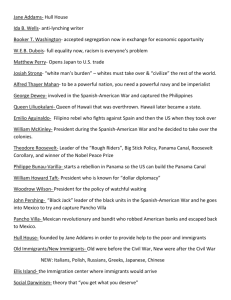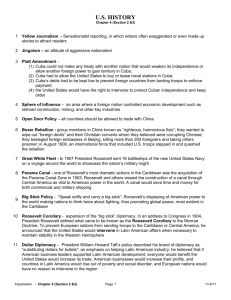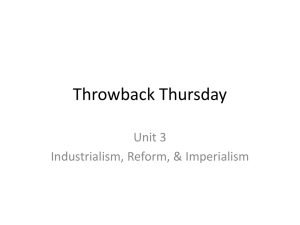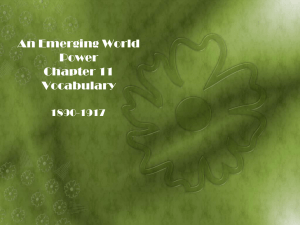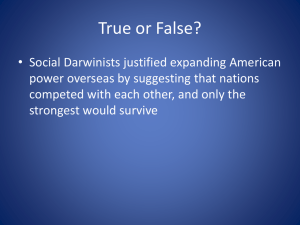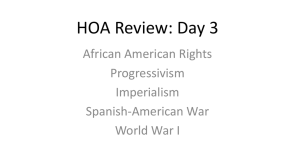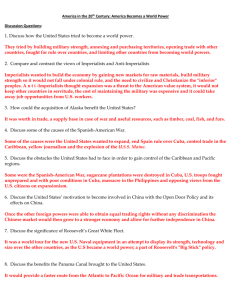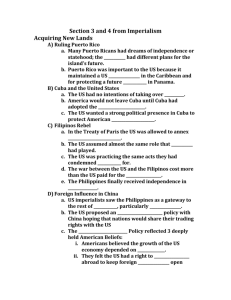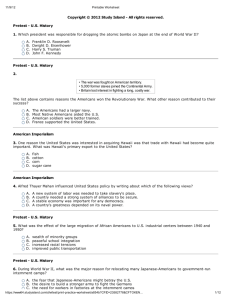ch.10 test
advertisement
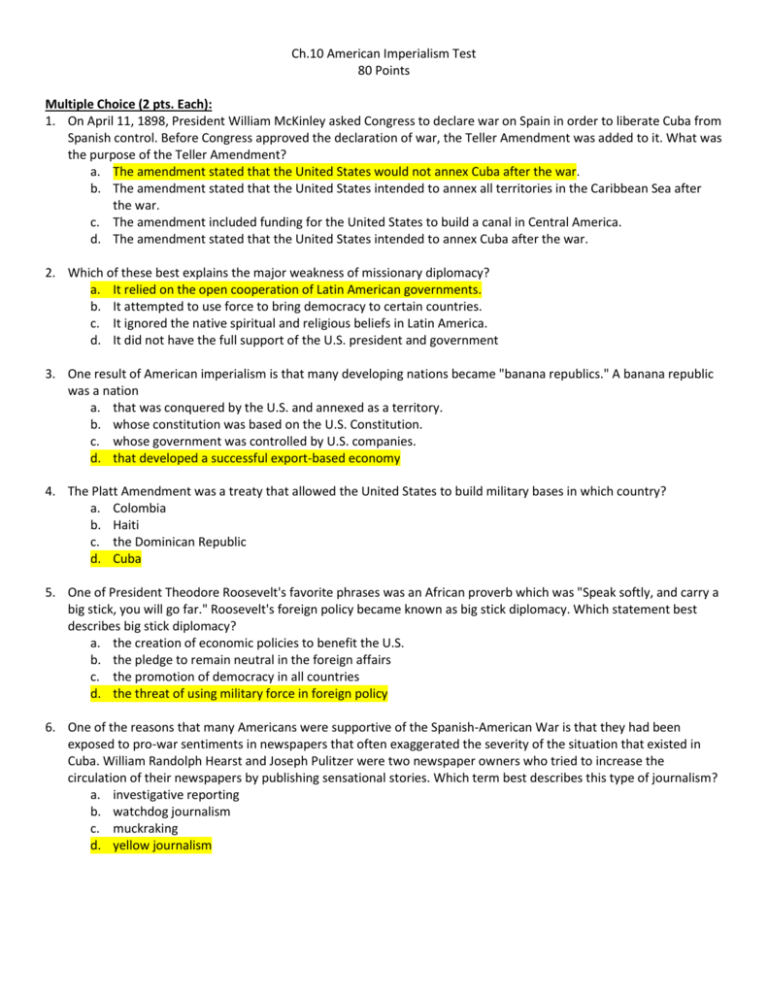
Ch.10 American Imperialism Test 80 Points Multiple Choice (2 pts. Each): 1. On April 11, 1898, President William McKinley asked Congress to declare war on Spain in order to liberate Cuba from Spanish control. Before Congress approved the declaration of war, the Teller Amendment was added to it. What was the purpose of the Teller Amendment? a. The amendment stated that the United States would not annex Cuba after the war. b. The amendment stated that the United States intended to annex all territories in the Caribbean Sea after the war. c. The amendment included funding for the United States to build a canal in Central America. d. The amendment stated that the United States intended to annex Cuba after the war. 2. Which of these best explains the major weakness of missionary diplomacy? a. It relied on the open cooperation of Latin American governments. b. It attempted to use force to bring democracy to certain countries. c. It ignored the native spiritual and religious beliefs in Latin America. d. It did not have the full support of the U.S. president and government 3. One result of American imperialism is that many developing nations became "banana republics." A banana republic was a nation a. that was conquered by the U.S. and annexed as a territory. b. whose constitution was based on the U.S. Constitution. c. whose government was controlled by U.S. companies. d. that developed a successful export-based economy 4. The Platt Amendment was a treaty that allowed the United States to build military bases in which country? a. Colombia b. Haiti c. the Dominican Republic d. Cuba 5. One of President Theodore Roosevelt's favorite phrases was an African proverb which was "Speak softly, and carry a big stick, you will go far." Roosevelt's foreign policy became known as big stick diplomacy. Which statement best describes big stick diplomacy? a. the creation of economic policies to benefit the U.S. b. the pledge to remain neutral in the foreign affairs c. the promotion of democracy in all countries d. the threat of using military force in foreign policy 6. One of the reasons that many Americans were supportive of the Spanish-American War is that they had been exposed to pro-war sentiments in newspapers that often exaggerated the severity of the situation that existed in Cuba. William Randolph Hearst and Joseph Pulitzer were two newspaper owners who tried to increase the circulation of their newspapers by publishing sensational stories. Which term best describes this type of journalism? a. investigative reporting b. watchdog journalism c. muckraking d. yellow journalism 7. In a 1904 address to Congress, President Theodore Roosevelt stated that the United States would intervene in the finances of countries in the Western Hemisphere who were unable to pay their debts to foreign creditors. Known as the Roosevelt Corollary, this was an addition to which U.S. foreign policy? a. the Monroe Doctrine b. the Open Door Policy c. the Treaty of Paris of 1898 d. the Hay-Bunau-Varilla Treaty 8. Which of the following best completes the chart? a. Jamaica b. Haiti c. the Philippines d. the Dominican Republic 9. The man pictured above is responsible for organizing a revolution against Queen Liliuokalani and replacing her with Sanford B. Dole. Who is he? a. John L. Stevens b. Thomas Jefferson c. Si Roberson d. None of the above 10. What year did construction on the Panama Canal start? a. 1915 b. 1900 c. 1904 d. 1902 11. Alfred Thayer Mahan influenced United States policy by writing about which of the following views? a. A country's greatness depended on its naval power. b. A stable economy was important for any democracy. c. A country needed a strong system of alliances to be secure. d. A new system of labor was needed to take slavery's place. 12. In 1902, Secretary of State John Hay negotiated a treaty with Colombian Foreign Minister Tomás Herrán in which the United States was granted permission to build a canal in Panama, which was controlled by Colombia at the time. The U.S. Senate approved this treaty, but the Colombian government did not. What did the United States do after the rejection of this treaty? a. The United States declared war on Colombia. b. The United States assisted in a Panamanian revolt against Colombia, and Panama became an independent country. c. The United States imposed a trade embargo on Colombia. d. The United States started to build its canal even though it did not have approval. 13. Which of the following is the correct amount spent on construction of the Panama Canal? a. $10 million b. $250 million c. $38,000 d. $380 million 14. Which treaty ended the Spanish-American War? a. the Hay-Bunau-Varilla Treaty b. the Treaty of Ghent c. the Treaty of Paris of 1898 d. the Treaty of Versailles 15. Which event contributed to the outbreak of the Spanish-American War? a. the construction of the Panama Canal b. the sinking of the Lusitania c. the border dispute between Venezuela and British Guiana d. the sinking of the USS Maine 16. The U.S. became a superpower around the turn of the twentieth century. This was because the U.S. was able to create a stepping stone to the commerce of a. Asia. b. Spain. c. Africa. d. Cuba. 17. The man pictured above was ordered to be captured dead or alive by U.S. National guardsmen after his attacks against Americans. Who is he? a. Rico Chavez b. Juan Ponce de Leon c. Pancho Villa d. Porfiro Diaz 18. Which of the following was a reason why the U.S. favored the construction of a canal across C. America? a. Increase naval effectiveness b. Increase trade between Colombia and Panama c. Improve commercial shipping times d. Open luxury cruise liners for Caribbean vacations 19. Why did President McKinley believe it was important for the United States to become involved in Cuba's interests prior to the Spanish American War? a. Cuba was a strong ally and a potential trading partner of the U.S. b. He wanted to protect American economic interests in the Caribbean. c. He wanted to defeat the Spanish in order to gain more land. d. He promised the Cubans defense against any foreign enemy. 20. One reason the United States was interested in acquiring Hawaii was that trade with Hawaii had become quite important. What was Hawaii's primary export to the United States? a. corn b. fish c. sugar cane d. cotton 21. The Open Door Policy expanded international trade in which country? a. Cuba b. The Philippines c. Mexico d. China 22. Which U.S. president felt it was the U.S.’s responsibility to deny recognition to any Latin American country that was oppressive or undemocratic? a. Theodore Roosevelt b. William Taft c. Woodrow Wilson d. Franklin D. Roosevelt 23. Which of these territories did the United States acquire as a result of the Spanish-American War? a. Panama b. Hawaii c. the Dominican Republic d. the Philippines 24. Which of the following describes America’s reason for imperialism during the late 19th century and early 20th century? a. Desire for military strength b. Thirst for new markets c. Belief in cultural superiority d. All of the above 25. What was the first territory that the United States acquired in the Pacific Ocean? a. Hawaii b. Guam c. The Philippines d. Samoa 26. Which of the following was NOT a way in which imperialism can influence a country? a. Economically b. Politically c. Religiously d. Militarily 27. The man pictured above is William Seward, he was the Secretary of State under President Lincoln and Johnson and is responsible for negotiating the annexation of what U.S. state from Russia? a. Hawaii b. Puerto Rico c. Alaska d. Oregon 28. During the Russo-Japanese war, the two countries were fighting over what territory? a. Spain b. Guam c. Philippines d. Korea 29. Which of the following treaties granted the U.S. exclusive rights to build and control the Canal Zone in Panama? a. Treaty of Paris b. Treaty of Guadalupe-Hidalgo c. Hay-Pauncefote Treaty d. Treaty of Colombia 30. President Taft (pictured above) is responsible for which of the following types of diplomacy that involved extending U.S. loans to Latin American countries to prevent European intervention? a. Missionary Diplomacy b. Dollar Diplomacy c. New Deal Diplomacy d. Big Stick Diplomacy 31. Which of the following events ended tensions between the U.S. and Mexico and ultimately avoided a war between the two countries? a. Stock Market Crash b. Invasion of Cuba c. WWI d. Pearl Harbor attack 32. What piece of legislation did Congress pass in 1900 that ended military rule in Puerto Rico and set up a civil government? a. Foraker Act b. Puerto Rican Independence Act c. Taft Amendment d. All of the above 33. Which of the following was the most important land victory experienced by the Americans during the SpanishAmerican war? a. Guantanamo Bay b. San Juan Hill c. Port of Havana d. Galveston Invasion 34. Which of the following best describes how Americans responded to the De Lome Letter? a. They were offended by the insults to President McKinley and became angry at Spain b. They agreed with the Spanish minister and called for McKinley’s resignation c. They disagreed with the contents of the letter but had little interest in the affairs occurring in Cuba d. None of the above 35. Which of the following was NOT a key belief about America’s capitalist economy reflected by the Open Door Notes? a. Believed growth of U.S. depended on exports b. Believed we had the right to intervene and keep foreign markets open c. Believed we should dominate Asian trade and push European influence out d. Felt closing of an area to American products, citizens, or ideas threated our survival as a country 36. Due to his involvement in the Treaty of Portsmouth, Theodore Roosevelt received what prestigious award? a. Medal of Honor b. Purple Heart c. Nobel Peace Prize d. Pulitzer Prize 37. Which of the following was an opinion that Americans had about Cuban independence? a. Many businessmen supported Spain to protect their investments b. Many felt we needed to help Cuban so that we could annex them c. Some Americans were enthusiastic about the Cuban cause of independence d. Both A & C 38. Which of the following were territories acquired in winning the Spanish-American War? a. Guam b. Puerto Rico c. Philippines d. All of the above 39. How did Queen Liliuokalani’s goal conflict with American imperialists goals? a. She wanted to extend the right to vote to Hawaiians by easing property requirements b. She favored ridding her country of American businessmen c. Her goals did not conflict d. Both A & B 40. What year was the construction of the Panama Canal completed? a. 1920 b. 1912 c. 1914 d. 1906
